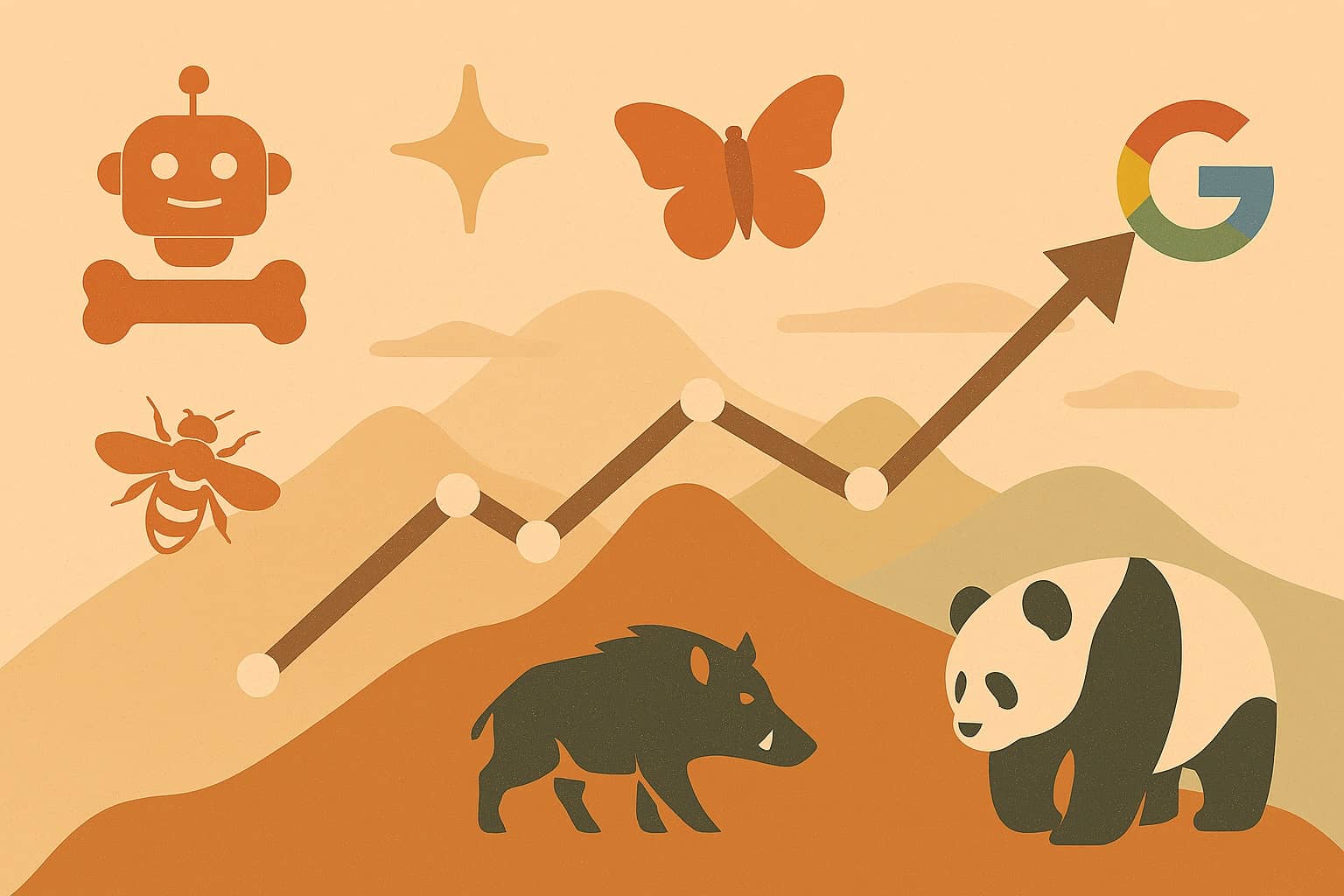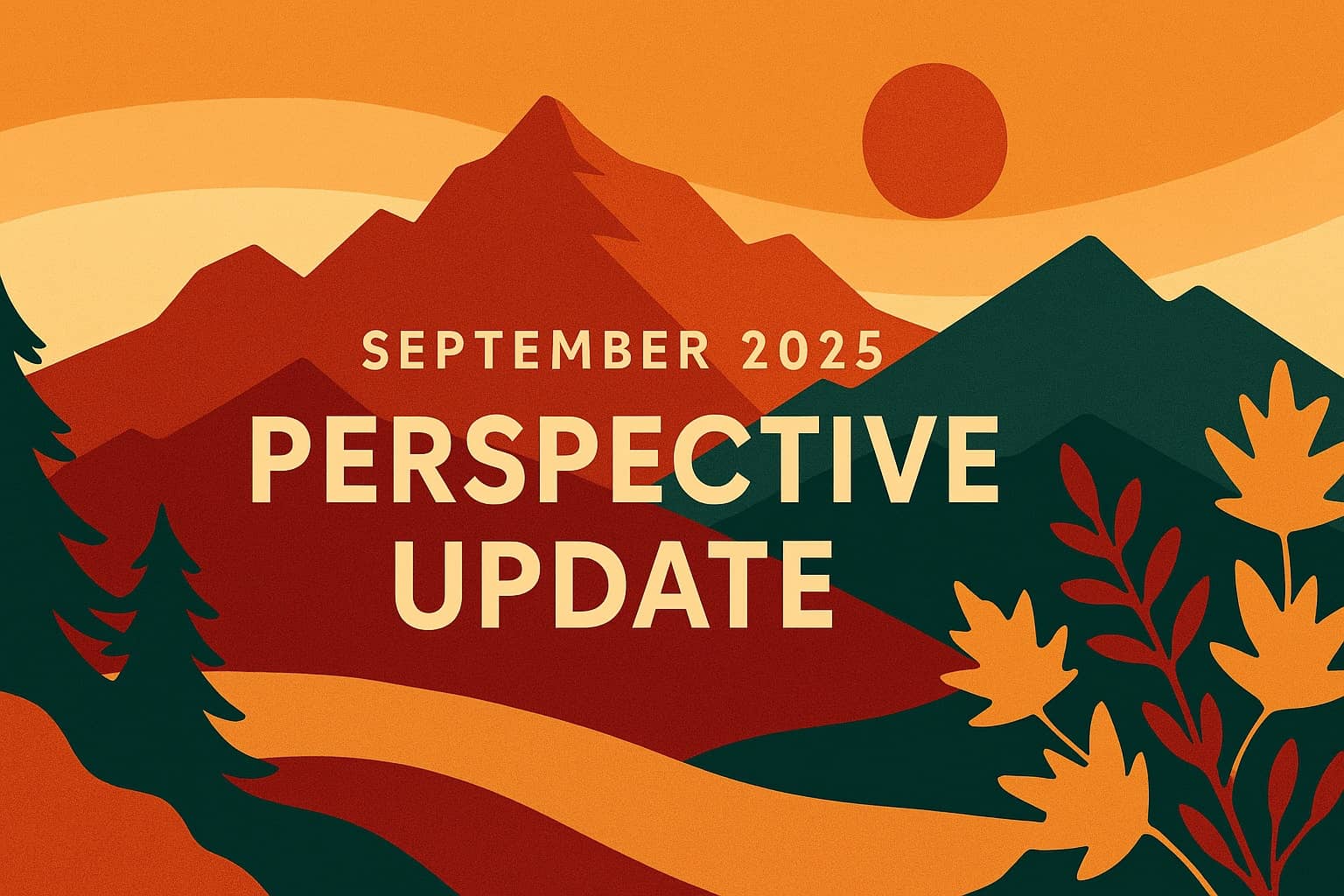table of contents
- A Comprehensive Timeline and Analysis of Google Search Algorithm Updates (1998–2025)
- 1. Early Foundations of Google Search Algorithm (1998–2003)
- 1.1. PageRank and the Foundations of Modern SEO (1998)
- Key Concepts:
- 2. Major Named Updates and the Link Era (2003–2010)
- 2.1. Boston, Cassandra, Dominic, Fritz (2003)
- 2.2. Florida Update (November 2003)
- 2.3. Jagger, Big Daddy, Universal Search (2005–2007)
- 3. Panda & Content Quality Era (2011–2015)
- 3.1. Panda (February 2011, Multiple Refreshes)
- 3.2. Penguin (April 2012, Ongoing through 2016)
- 4. Semantic Search & AI Introduction (Hummingbird, RankBrain, MUM)
- 4.1. Hummingbird (August 2013)
- 4.2. RankBrain (October 2015)
- 4.3. MUM (2021)
- 5. E-E-A-T & YMYL Emphasis, Core Updates (2018–2025)
- 5.1. Medic Update (August 2018)
- 5.2. Core Update Era (2018–Present)
- 6. Mobile and User Experience-Driven Updates
- 6.1. Mobilegeddon (April 2015 & May 2016)
- 6.2. Core Web Vitals and Page Experience (2021+)
- 7. AI-Driven SERP Features & Helpful Content Systems (2019–2025)
- 7.1. BERT (October 2019)
- 7.2. Helpful Content Update (August 2022 & Ongoing)
- 7.3. AI Overviews & Zero-Click Search (2024–2025)
- 8. Spam Updates & Penalty Mechanisms: SpamBrain and Beyond
- 8.1. SpamBrain (AI System, 2018+, Named Late 2022)
- 9. Technical Optimization Priorities
- 9.1. Schema/Structured Data
- 9.2. HTTPS, Security, and Clean Architecture
- 10. Ethical SEO Strategies: From Linkbuilding to E-E-A-T (1998–2025)
- 11. Communication, Community Response, and Transparency
- 12. Ongoing Volatility, Micro-Updates, and the Future
- want a FREE Penalty Check?
- Conclusion: The Evolving Pillars of Modern, Ethical SEO (2025 Onwards)
- Table: Major Google Algorithm Updates (2003–2025)
A Comprehensive Timeline and Analysis of Google Search Algorithm Updates (1998–2025)
Google Search is a living, breathing system, continuously evolving through major algorithm updates that shape the digital information ecosystem. Since its inception in 1998, Google’s mission has been to organize the world’s information and make it universally accessible and useful. Achieving this mission has entailed constantly refining ranking algorithms to deliver more relevant, trustworthy, and ethical search results. Each landmark update—whether Panda, Penguin, Hummingbird, BERT, or the recent 2025 core updates—has both responded to shifts in user behavior and catalyzed significant changes in SEO practices. This report presents a detailed historical timeline and analysis of Google Search algorithm updates, focusing on their release dates, central objectives, and their enduring impact on SEO, content quality standards, and technical optimization. Special attention is given to ethical SEO strategy evolution, how Google communicated updates, the SEO community’s response, and the shifting landscape of ranking factors and penalties.
For ease of reference, the article is structured in an era- and update-centered format, facilitating an understanding of cause and effect in algorithmic change. A comparison table summarizes the most significant updates, and analytical commentary follows each major update or theme.

1. Early Foundations of Google Search Algorithm (1998–2003)
1.1. PageRank and the Foundations of Modern SEO (1998)
PageRank was unveiled by Google’s founders, Larry Page and Sergey Brin, as a revolutionary approach to search ranking based on link analysis. Unlike prior search engines, which relied primarily on keyword matching, PageRank viewed hyperlinks as academic citations, a form of endorsement or trust.
Key Concepts:
- Link as Vote: Importance was determined by the quantity and quality of inbound links.
- Recursive Quality: A link from a high-quality (high-PageRank) site offered greater value than links from lower-quality sites.
- Random Surfer Model: The user behavior was abstracted as a “random walker,” providing a mathematical foundation for global link analysis.
SEO Impact: PageRank was an enormous leap forward in ranking reliability and resistance to simple keyword manipulation. But it also sparked widespread link spam, leading to a cyclical arms race between bad actors and Google’s anti-spam advances.
2. Major Named Updates and the Link Era (2003–2010)
This period saw the dawn of named algorithm updates, with Google explicitly communicating extensive changes. It marked the beginning of Google’s ongoing war against manipulation and spam.
2.1. Boston, Cassandra, Dominic, Fritz (2003)
Boston (February 2003) was the first officially named algorithm update, announced publicly and signaling the era of frequent, incremental adjustments. Subsequent updates, Cassandra (hidden text/link crackdown), Dominic (link structure counting), and Fritz (shift from monthly to daily updates), set a precedent for transparency and continuous improvement.
- Updates targeted increasingly subtle forms of spam and manipulation.
- Incremental (rather than all-at-once) updates began, a precursor to today’s rolling core updates.
2.2. Florida Update (November 2003)
Focus: Strict penalties for keyword stuffing, doorway pages, and low-quality affiliate sites. This update devastated businesses reliant on over-optimization and black-hat techniques.
- Many sites saw precipitous ranking drops; industry forums exploded with complaints.
- The update ushered in a new era of ethical SEO, where true content quality and diversity of signals (not gaming the system) became essential for sustainable success.
2.3. Jagger, Big Daddy, Universal Search (2005–2007)
Jagger (2005) further cracked down on paid links and semantic spam, while Big Daddy (2006) improved canonicalization, redirect handling, and technical site architecture—they established technical SEO as an essential discipline.
In 2007, Universal Search began blending news, local, video, and image results into SERPs, forever changing visibility strategies and the importance of structured data and multimedia content.
3. Panda & Content Quality Era (2011–2015)
3.1. Panda (February 2011, Multiple Refreshes)
Core Focus: Reduce rankings for thin, duplicate, and low-quality content, especially “content farms” designed for search volume rather than user value.
- Up to 12% of queries were affected in the initial rollout.
- Site-wide and section-wide demotions: poor content anywhere could sink an entire domain.
- Sites were compelled to invest in in-depth, original, user-centric content; content audits became a best practice.
- Remove or rewrite thin/duplicated content.
- Regularly update articles, improve author signals, and maintain a balanced ad-to-content ratio.
- Panic initially, as many businesses’ traffic cratered.
- Over time, Panda was lauded for restoring trust in organic search.
3.2. Penguin (April 2012, Ongoing through 2016)
Core Focus: Combat manipulative link schemes, including paid/backlink farms, unnatural anchor text, and spam networks.
- Sites with toxic backlink profiles were penalized (sitewide at first, then granularly after Penguin 4.0 in 2016).
- Disavow file and manual outreach for link removal became key tactics.
- Moved link building toward “white hat” digital PR, editorial outreach, and topical relevance.
- Reinforced the principle that links should be earned, not bought or traded.
- Google began announcing Penguin updates in advance; offered reconsideration requests for manual penalties.
- Industry forums and blogs flourished, allowing SEOs to compare case studies and share recovery stories.
4. Semantic Search & AI Introduction (Hummingbird, RankBrain, MUM)
4.1. Hummingbird (August 2013)
Focus: Complete rewrite of core search; emphasized semantic search, natural language, and query intent over strict keyword matching.
- Content strategies evolved from targeting specific keywords to covering broader topics and user intent.
- Rise of “topic clusters” and pillar pages.
- Emphasis grew on conversational, question-based content, foreshadowing the coming voice and AI search boom.
4.2. RankBrain (October 2015)
SEO Priority:
- Focus on signaling relevance through comprehensive, engaging, naturally written content.
- Technical optimization of metadata, internal linking, and mobile UX.
4.3. MUM (2021)
SEO Response:
- Multimedia and entity-focused strategies became crucial; schema markup, structured data, and topical authority rose in importance.
5. E-E-A-T & YMYL Emphasis, Core Updates (2018–2025)
5.1. Medic Update (August 2018)
Implications:
- Major volatility for health and finance sites, with those emphasizing credentials, bylines, and sourcing gaining an advantage.
- Transparency, citation, author bios, and positive reputation signals became core ranking factors.
- Recovery focused on building trust, expert-driven commentary, and a clear editorial process.
5.2. Core Update Era (2018–Present)
Key Themes:
- Content depth, recency, and topical relevance
- E-E-A-T signals expanded to “Experience” in 2022–2023: firsthand knowledge, authenticity, and demonstration of the author’s or entity’s qualifications now matter.
- Technical health, structured data, accessibility, and mobile-first design are minimum expectations.
- Google communicates rollouts via the Search Central Blog and @searchliaison on X/Twitter.
- Danny Sullivan, as Search Liaison (2017–2025), played a pivotal role in clarifying and humanizing updates; his departure in August 2025 marks a new era.
- Google encourages patience and data analysis over knee-jerk reactions, stressing “quality and user-first” as the north star for recovery.
6. Mobile and User Experience-Driven Updates
6.1. Mobilegeddon (April 2015 & May 2016)
SEO Impact:
- Non-mobile sites saw significant traffic drops from mobile users.
- UX, testing, and speed optimization tools became central to SEO toolkits.
- Marked the start of “mobile-first indexing” (2018+), where Google primarily uses the mobile version of content for crawling and ranking.
6.2. Core Web Vitals and Page Experience (2021+)
Focus: Technical metrics (Largest Contentful Paint, Interaction to Next Paint, Cumulative Layout Shift), combined with HTTPS, safe browsing, and mobile-friendliness.
- CWV is a confirmed ranking factor and can tip competitive rankings.
- Real-user (field) data is prioritized; fast, stable, seamless sites earn better visibility.
- Optimization requires collaborative work between marketers and web developers.
7. AI-Driven SERP Features & Helpful Content Systems (2019–2025)
7.1. BERT (October 2019)
Impact:
- Improved query interpretation, especially long-tail and conversational searches.
- Featured snippets and “People Also Ask” boxes became more relevant.
- Rewarded well-structured, clear, and naturally written content that addresses user questions specifically.
7.2. Helpful Content Update (August 2022 & Ongoing)
Practical Effects:
- New site-wide signals can affect all rankings, not just guilty pages.
- Heavy penalties for auto-generated, thin, or generic content.
- Content that thoroughly answers queries, demonstrates experience, and provides unique insight is rewarded.
- SEO strategies have shifted from “high-volume publishing” to “high-value publishing,” focusing on originality, author bios, citations, and depth.
7.3. AI Overviews & Zero-Click Search (2024–2025)
SEO Challenge:
- Reduced organic clicks for many informational queries.
- Forced content creators to shift to targeting complex, in-depth, or intent-rich searches where users still want full articles and will click through.
- Structured data, FAQ/schema, and concise question answering improved chances of inclusion in AI Overviews.
8. Spam Updates & Penalty Mechanisms: SpamBrain and Beyond
8.1. SpamBrain (AI System, 2018+, Named Late 2022)
Recent Focus Areas (2023–2025):
- Link spam: Sending, selling, or purchasing backlinks for ranking.
- Scaled content abuse: Mass-producing generic/AI-based text to game rankings.
- Expired domain abuse: Repurposing “retired” reputable domains solely to manipulate SERP position.
- Parasite SEO/Site reputation abuse: Hosting unrelated or spammy third-party content on high-authority sites.
- Automated demotion, manual actions, and public penalties.
- Google actively communicates these changes, provides spam reporting forms, and issues regular spam-fighting reports.
9. Technical Optimization Priorities
9.1. Schema/Structured Data
Core updates and AI enhancements rely heavily on structured data (schema.org); this improves the ability of Google to understand content, attributes, authorship, and product/service specifics.
9.2. HTTPS, Security, and Clean Architecture
Sites without HTTPS or cluttered, broken structures rank lower and risk being flagged as untrustworthy or spammy. Cleanliness, crawlability, and compliance are core technical ranking requirements.
10. Ethical SEO Strategies: From Linkbuilding to E-E-A-T (1998–2025)
Early Era (1998–2010):
- White-hat SEO focused on content quality, link outreach, and transparency.
- Black-hat tactics (spam, keyword stuffing, cloaking) dominated until anti-manipulation updates punished bad actors.
Content Quality Era (2011–2013):
- Panda and Penguin enforced unique, value-driven content and ethical link building.
- Technical SEO (site speed, canonicalization, mobile UX) rose in importance.
E-A-T & YMYL Era (2014–2020):
- Demand for credentials and expertise, especially in YMYL spaces.
- Sites are now expected to clearly display who wrote the content, their expertise, sources, and external trust signals.
AI, E-E-A-T, and Generative Era (2020–2025):
- User engagement (dwell time, bounce, click-through rates), entity authority, and brand reputation join the ranking mix.
- Optimizing for helpfulness, authenticity, trust, and technical reliability became non-negotiable.
11. Communication, Community Response, and Transparency
- Major updates are announced on the Search Central Blog, in webmaster forums, and on the @searchliaison X (Twitter) account.
- Danny Sullivan, as Search Liaison (2017–2025), played a key role in demystifying changes, especially core, spam, and helpful content updates.
- The SEO community (blogs, forums, third-party tracking tools) provides rapid feedback, ranks volatility, and often influences clarification and even the fine-tuning of search policies.
12. Ongoing Volatility, Micro-Updates, and the Future
- Google now processes hundreds of tweaks annually, with a handful qualifying as “core” or “named” events.
- Micro-volatility is now the norm, demanding constant adaptation, monitoring, and readiness for rapid response.
- Experiments, sector-specific ranking adjustments (health, news, reviews), and international changes are frequent.
- Industry tools and SEO media provide invaluable tracking and analysis, supplementing Google’s own (occasionally vague) communication.
- Hyper-personalized, AI-driven SERPs.
- Deep integration of voice, visual, and conversational search.
- Sustained emphasis on authenticity, usefulness, topical authority, and technical excellence.
Conclusion: The Evolving Pillars of Modern, Ethical SEO (2025 Onwards)
- Value-First Content: Deep, unique, authoritative, and satisfying real-world user needs.
- Trust and E-E-A-T: Demonstrable experience, credentials, transparency, and reputation.
- Technical Excellence: Fast, stable, mobile-optimized, well-structured, secure sites aligned with Core Web Vitals.
- Ethical Link Ecosystem: Earned, relevant, editorially-given links; avoidance of manipulation or shortcuts.
- Agility and Monitoring: Continuous tracking of algorithmic changes, search feature shifts, and SERP volatility.
- Proactive Adaptation: Rapid alignment with emerging priorities—AI summarization, rich media, schema, and structured data.
Table: Major Google Algorithm Updates (2003–2025)
| Update Name | Release Date | Core Focus | SEO Impact |
|---|---|---|---|
| Florida | Nov 2003 | Keyword stuffing, link spam | Penalized manipulative tactics, kicked off the “named updates” era |
| Panda | Feb 2011 | Content quality, thin/duplicated content | Penalized low-quality content farms, 12% of results affected |
| Penguin | Apr 2012 | Link spam, manipulative backlinks | Penalized paid/unnatural links, shifted focus to link quality |
| Hummingbird | Aug 2013 | Semantic search, user intent | Improved query understanding, enabled conversational/voice search |
| Pigeon | Jul 2014 | Local search, geolocation signals | Refined local pack, importance of business proximity and citations |
| Mobilegeddon | Apr 2015 | Mobile usability | Penalized non-mobile-friendly sites in mobile rankings |
| RankBrain | Oct 2015 | Machine learning, ambiguous queries | Third-most important ranking factor, improved query intent matching |
| Medic | Aug 2018 | YMYL, E-A-T | Affected health, finance, law niches; prioritized trust/authority |
| BERT | Oct 2019 | Natural language understanding, context | Improved complex query matching, applied to 10%+ of queries |
| Helpful Content | Aug 2022 | People-first, value-added content | Penalized unhelpful/AI-generated content, rewarded authentic articles |
| SpamBrain | Dec 2022 | Spam/link spam detection via AI | Neutralized link spam, enhanced automated spam filtering |
| Core Web Vitals | Jun 2021+ | Page experience, speed, interactivity | Elevated technical optimization priorities (LCP, FID/INP, CLS) |
| AI Overviews | May 2024 | Generative AI summaries in SERP | Reduced clicks, zero-click search surge, required new SEO strategies |
| Site Reputation Abuse | Nov 2024 | Parasite SEO, content reputation | Penalized third-party content manipulation on high-authority domains |
| March, June, Aug 2025 Core/Spam Updates | 2025 | E-A-T, AI spam, trust, diversity | Prioritized trust, improved SERP diversity, penalized spam/AI content |




